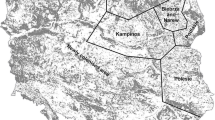Abstract
Inferences about abundance often are based on unadjusted counts of individuals observed, in part, because of the large amount of data required to generate reliable estimates of abundance. Where capture-recapture data are sparse, aggregating data across multiple sample elements by pooling species, locations, and sampling periods increases the information available for modeling detection probability, a necessary step for estimating abundance reliably. The process of aggregating sample elements involves balancing trade-offs related to the number of aggregated elements; although larger aggregates increase the amount of information available for estimation, they often require more complex models. We describe a heuristic approach for aggregating data for studies with multiple sample elements, use simulated data to evaluate the efficacy of aggregation, and illustrate the approach using data from a field study. Aggregating data systematically improved reliability of model selection and increased accuracy of abundance estimates while still providing estimates of abundance for each original sample unit, an important benefit necessary to maintain the design and sampling structure of a study. Within the framework of capture-recapture sampling, aggregating data improves estimates of abundance and increases the reliability of subsequent inferences made from sparse data. Additional tables and datasets may be found in the online supplements.
Similar content being viewed by others
References
Alldredge, M. W., Pollock, K. H., Simons, T. R., and Shriner, S. A. (2007), “Multiple-Species Analysis of Point Count Data: A More Parsimonious Modelling Framework,” Journal of Applied Ecology, 44, 281–290.
Anderson, D. R., Burnham, K. P., and White, G. C. (1994), “AIC Model Selection in Overdispersed Capture-Recapture Data,” Ecology, 75, 1780–1793.
Bowden, D. C., White, G. C., Franklin, A. B., and Ganey, J. L. (2003), “Estimating Population Size With Correlated Sampling Unit Estimates,” Journal of Wildlife Management, 67, 1–10.
Boyce, M. S., MacKenzie, D. I., Manly, B. F. J., Haroldson, M. A., and Moody, D. (2001), “Negative Binomial Models for Abundance Estimation of Multiple Closed Populations,” Journal of Wildlife Management, 65, 498–509.
Buckland, S. T., Anderson, D. R., Burnham, K. P., and Laake, J. L. (1993), Distance Sampling: Estimating Abundance of Biological Populations, New York: Chapman & Hall.
Burnham, K. P., and Anderson, D. R. (2002), Model Selection and Multimodel Inference: A Practical Information-Theoretic Approach (2nd ed.), New York: Springer.
Clark, J. S. (2005), “Why Environmental Scientists Are Becoming Bayesians,” Ecology Letters, 8, 2–14.
J. S. Clark, and A. E. Gelfand (eds.) (2006), Hierarchical Modeling for the Environmental Sciences, Oxford: Oxford University Press.
Clark, J. S., and LaDeau, S. (2006), “Synthesizing Ecological Experiments and Observational Data With Hierarchical Bayes,” in Hierarchical Modeling for the Environmental Sciences, eds. J. S. Clark, and A. E. Gelfand, Oxford: Oxford University Press, pp. 41–58.
Congdon, P. (2003), Applied Bayesian Modelling, West Sussex: Wiley.
Conn, P. B., Arthur, A. D., Bailey, L. L., and Singleton, G. R. (2006), “Estimating the Abundance of Mouse Populations of Known Size: Promises and Pitfalls of New Methods,” Ecological Applications, 16, 829–837.
Hammond, E. L., and Anthony, R. G. (2006), “Mark-Recapture Estimates of Population Parameters for Selected Species of Small Mammals,” Journal of Mammalogy, 87, 618–627.
Hargrove, J. W., and Borland, C. H. (1994), “Pooled Population Parameter Estimates From Mark-Recapture Data,” Biometrics, 50, 1129–1141.
Kéry, M., and Royle, J. A. (2008), “Hierarchical Bayes Estimation of Species Richness and Occupancy in Spatially Replicated Surveys,” Journal of Applied Ecology, 45, 589–598.
Litt, A. R. (2007), “Effects of Experimental Fire and Nonnative Grass Invasion on Small Mammals and Insects,” unpublished Ph.D. dissertation, University of Arizona, School of Natural Resources.
Lynam, A. J., Rabinowitz, A., Myint, T., Maung, M., Latt, K. T., and Po, A. H. T. (2009), “Estimating Abundance With Sparse Data: Tigers in Northern Myanmar,” Population Ecology, 51, 115–121.
MacKenzie, D. I., and Kendall, W. L. (2002), “How Should Detection Probability Be Incorporated Into Estimates of Relative Abundance?” Ecology, 83, 2327–2393.
MacKenzie, D. I., Nichols, J. D., Sutton, N., Kawanishi, K., and Bailey, L. L. (2005), “Improving Inferences in Population Studies of Rare Species That Are Detected Imperfectly,” Ecology, 86, 1101–1113.
McCarthy, M. A. (2007), Bayesian Methods for Ecology, Cambridge: Cambridge University Press.
McKelvey, K. S., and Pearson, D. E. (2001), “Population Estimation With Sparse Data: The Role of Estimators versus Indices Revisited,” Canadian Journal of Zoology, 79, 1754–1765.
Nichols, J. D. (1986), “On the Use of Enumeration Estimators for Interspecific Comparisons, With Comments on a ‘Trappability’ Estimator,” Journal of Mammalogy, 67, 590–593.
— (1992), “Capture-Recapture Models: Using Marked Animals to Study Population Dynamics,” BioScience, 42, 94–102.
Otis, D. L., Burnham, K. P., White, G. C., and Anderson, D. R. (1978), “Statistical Inference From Capture Data on Closed Animal Populations,” Wildlife Monographs, 62, 1–135.
Rosenberg, D. K., Overton, W. S., and Anthony, R. G. (1995), “Estimation of Animal Abundance When Capture Probabilities Are Low and Heterogeneous,” Journal of Wildlife Management, 59, 252–261.
Rosenberg, D. K., Swindle, K. A., and Anthony, R. G. (2003), “Influence of Prey Abundance on Northern Spotted Owl Reproductive Success in Western Oregon,” Canadian Journal of Zoology, 81, 1715–1725.
Schwarz, C. J., and Seber, G. A. F. (1999), “Estimating Animal Abundance: Review III,” Statistical Science, 14, 427–456.
Seber, G. A. F. (1982), Estimation of Animal Abundance and Related Parameters, New York: Macmillan.
— (1986), “A Review of Estimating Animal Abundance,” Biometrics, 42, 267–292.
— (1992), “A Review of Estimating Animal Abundance II,” International Statistical Review, 60, 129–166.
Skalski, J. R., Robson, D. S., and Simmons, M. A. (1983), “Comparative Census Procedures Using Single Mark-Recapture Methods,” Ecology, 64, 752–760.
White, G. C. (2005), “Correcting Wildlife Counts Using Detection Probabilities,” Wildlife Research, 32, 211–216.
White, G. C., and Burnham, K. P. (1999), “Program MARK: Survival Estimation From Populations of Marked Animals,” Bird Study, 46 (Suppl.), 120–138.
Author information
Authors and Affiliations
Corresponding author
Electronic Supplementary Material
Rights and permissions
About this article
Cite this article
Litt, A.R., Steidl, R.J. Improving Estimates of Abundance by Aggregating Sparse Capture-Recapture Data. JABES 15, 228–247 (2010). https://doi.org/10.1007/s13253-009-0017-7
Received:
Revised:
Published:
Issue Date:
DOI: https://doi.org/10.1007/s13253-009-0017-7




